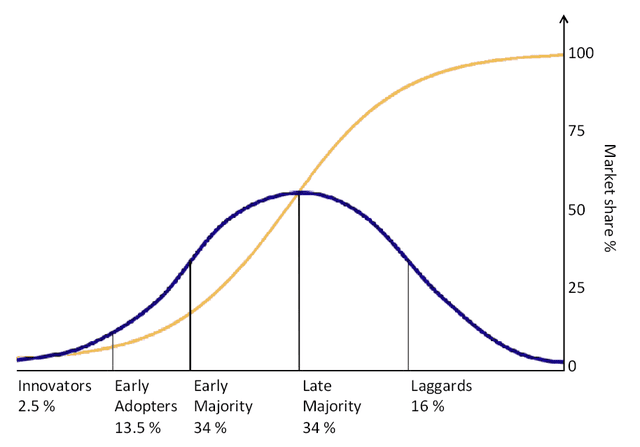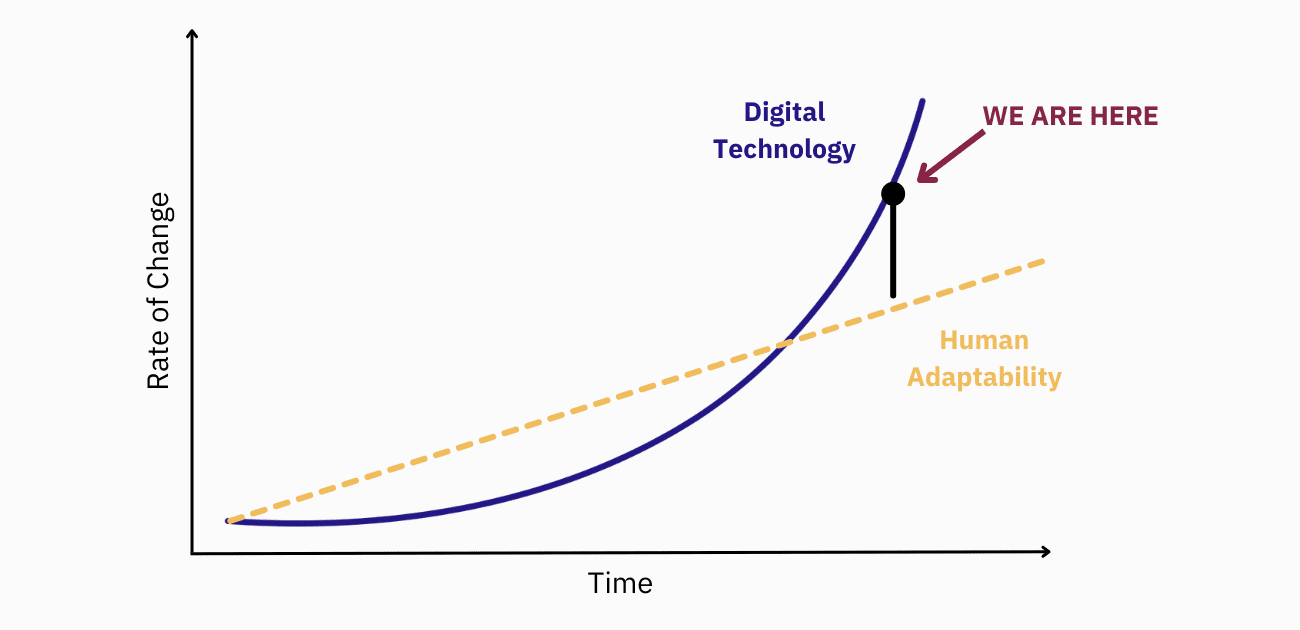
Technology has changed the way we operate. It has altered our lifestyles, preferences, and the way we spend our time and resources. However, not all technologies are adopted at the same pace.
In 1999, V.H. Carr defined technology adoption as “the stage of selecting a technology for use by an individual or an organization’.”
Technology adoption is not related to the aspects of technology alone. It is a complex process involving user attitude and personality, social influence, trust, and other facilitating conditions that impact overall mass technology diffusion and user adoption.
What Is Technology Adoption?
Technology adoption is the process by which people or organizations accept and use new technologies. It involves learning and adapting to new technologies. Technology adoption is affected by performance expectancy, effort expectancy, facilitating conditions, and social influence.
What Is the Technology Adoption Curve?
The technology adoption curve is a bell curve model that describes how different people react to, adopt, and accept new innovative products and technologies. While there are many adaptions of the original model, Everett Rogers’s diffusion of innovations dives into the characteristics of each of the five adopter categories within the technology adoption life cycle: innovators, early adopters, early majority, late majority, and laggards.

Why is this important for enterprise organizations? Because every time you implement new technology, you have to win over every type of adopter.
What Are the 5 Stages Of Technology Adopters?
- Innovators
- Early Adopters
- Early Majority
- Late Majority
- Laggards
Defining the 5 Stages Of the Technology Adoption Lifecycle
Each category of technology adopter has different motivators when adopting new processes and technologies.
1. Innovators (2.5%)
Innovators are those who are willing to take risks. Innovators are those in the technology adoption life cycle who love trying new things and may even be the people encouraging others to try out a new app or tool.
Adopters from this part of the technology adoption curve like going against the grain and trying new things. They’re the first to upgrade their phones or experiment with a tool during beta testing. Because innovators are rarely concerned about failure, they’re very willing to give a new technology a shot.
In fact, innovators are often the initiators of change. If you’re the person introducing new technology into your organization, you’re an innovator.
Innovator Traits Include:
- Enthusiastic about new technology
- Willing to take risks
- Not concerned with the idea of failure
What motivates innovators?
To motivate innovators, focus on the exciting opportunities the new technology presents. Although innovators don’t need much convincing, the best way to motivate them is to get them excited about what a new tool can do.
The enhanced Kotter’s 8-step change model is a helpful resource for motivating innovators because the model is built around “the big opportunity.” Every step is designed to encourage your team to move forward. Because innovators are less likely to resist a new tool, they are quick to join what Kotter calls a “volunteer army” — people who enthusiastically support a transformation.
Let’s say you want to use a digital adoption platform to onboard employees to a new piece of software. The big opportunity is being able to save on content creation time, improve user adoption rates company-wide, and increase productivity. Innovators will be intrigued by the tool and interested in how it can improve their work.
2. Early Adopters (13.5%)
While early adopters are trendsetters and tend to be comfortable taking risks, they want to form a solid opinion of technology before they vocally support it.
Early adopters love being the first to know about new technology. These people are quick to sign up for new social media sites or experiment with a new project management tool just for fun. What separates early adopters from innovators is early adopters’ concerns about their reputation.
While innovators are comfortable failing publicly, early adopters like to gather information and personal experience with technology before they recommend it to others. When asked about new tech, early adopters want to appear knowledgeable and trendy, which is why they need to test a tool out before they’ll throw their support behind it.
Early Adopter Traits Include:
- Persuasive
- Willing to work through early bugs and setbacks
- Concerned about their reputation
What motivates early adopters?
To motivate early adopters, provide guides on how to get started. Early adopters want to hit the ground running. By giving them the guides and training they need to start using a tool, they can become internal champions for your organizational change.
Consider using these early adopters of the technology adoption life cycle as a test group to work out kinks in implementation. Because early adopters accept small setbacks and issues, they are ideal beta testers. And once they feel comfortable with a new tool, they’re quick to spread the word to others.
Help early adopters master new technology by providing training in a variety of formats, such as walkthroughs, written guides, and video training. It’s important to address different learning styles and provide self-paced learning opportunities. The more knowledgeable early adopters feel about technology, the more likely they are to promote it to their coworkers.
3. Early Majority (34%)
The early majority are interested in technology but want proof of its effectiveness. These are the people who scour product reviews before making a purchase, and they quietly test out tools before committing. Case studies and real-life user stories trump generic promises of what a tool or program can do.
For adopters in this category of the technology adoption curve, you’ll need a pragmatic approach. Go to the early majority with evidence of what technology can accomplish.
Early Majority Traits Include:
- Logical
- Practical
- Data-driven
What motivates the early majority?
To motivate the early majority, show how the new technology solves a problem. To win over the early majority, you need to demonstrate what problem the technology solves and how it does so. Remember, this adopter category responds to data-driven arguments, so show these users how your solution has solved a similar problem in the past.
For example, if you plan to use a DAP to train employees, the early majority will want to see the facts of the current situation, as well as evidence, in the form of a few other digital adoption success stories, to prove that your proposed solution is the best option. Present a clear argument.
Let’s take an example of improving Salesforce adoption.
- Problem: Our learning and development (L&D) team is overrun with questions about using Salesforce and does not have the capacity for one-on-one explanations and training.
- Solution: Use a DAP to provide self-guided, in-app training for employees.
- Evidence: PlanetHS, LLC employees spent too much time on one-on-one calls training parents, students, and athletic directors. With each call lasting 45 minutes or more, the support team was constantly backlogged with support requests. A DAP replaced calls with in-app training, eliminating 190,000 support tickets.
The key to winning over the early majority is showing that your solution is the most logical choice.
4. Late Majority (34%)
Much like the early majority, the late majority want a data-driven reason to adopt technology. Convincing people in this adopter category requires research and solid proof that the technology is worth their time.
People in the late majority do not like to take risks, and they tend to question the need for changes. They are not easily persuaded by trends, preferring instead to watch how changes play out before they get involved. These are the people who hit snooze on software updates for as long as they can, waiting to hear how their peers react to the updates.
Late Majority Traits Include:
- Cautious
- Logical
- Do not like to take risk
What motivates the late majority?
To motivate the early majority, show them the new technology in action. The late majority needs to see it to believe it. At this stage of the technology adoption curve, you’ll need extensive research and proof that the new technology is effective.
Use your innovators and early adopters to show how the tool or software serves your organization. Late majority adopters appreciate seeing how technology relates to their jobs specifically, so turn your early users within the company into vocal supporters of new technology.
Be sure to demonstrate the specific uses and benefits, and prove the value with data. Let’s say you want everyone on the team to download Slack and move all internal communication from email to Slack channels. Generalized benefits like “Slack is faster and easier than email” won’t resonate with the late majority. They want the facts.
Instead, have innovators and early adopters use a tool like RescueTime to track time spent on communication using email for one week and repeat the experiment with Slack. Then, go to the late majority with productivity numbers from within the organization. They’ll respond better to an argument backed by data, especially if the data comes from people they know and work with.
5. Laggards (16%)
Laggards are wary of new technology. Before they consider getting on board, they need answers to their “what’s in it for me?” (WIIFM) questions.
Laggards prefer the status quo because they know what to expect. They are your most stubborn users — easily frustrated by new technology and quick to give up on a tool that does not immediately make their life easier.
For myself, I think of my dad’s relationship with the Internet as an example of a technology laggard.
When talking to laggards, answer WIIFM questions, such as:
- How does this technology benefit me personally?
- Will this improve how my team or I work?
- What’s wrong with the current tool, and what makes this new tool better?
Addressing WIIFM questions helps you move past initial reservations so you can focus on convincing laggards to embrace something new.
Laggard Traits Include:
- Skeptical
- Resistant to change
- Wary of new technology
What motivates laggards?
To motivate laggards, demonstrate how the new technology has helped other users succeed. Combat skepticism by showing laggards how technology has helped other users within their same organization or team.
Use the time that laggards spend avoiding the new tool to gather data from other users. Just like the late majority, laggards want documented success stories from their coworkers. However, laggards aren’t as easily convinced — the aforementioned Slack example would not impress them. Increased productivity is great, but it doesn’t have a strong enough personal benefit to pull laggards out of their comfort zone.
Go to the laggards with proof of effectiveness, and put a heavy focus on user benefits. For example, “Using Salesforce helped these 20 sales agents increase their commissions by 15% in just two months” instead of “Using Salesforce will help us respond to leads faster.”
Software clicks better with Whatfix's digital adoption platform
Enable your employees with in-app guidance, self-help support, process changes alerts, pop-ups for department announcements, and field validations to improve data accuracy.
Examples Of Technology Adoption
Let’s dive deep into some practical examples of technology adoption.
According to the International Energy Agency, sales of electric cars reached 3.2 million in 2020, up from just 17,000 in 2010. Electric vehicles are gradually gaining popularity as people become more conscious of the environmental impact of gasoline-powered vehicles.
The adoption of electric vehicles has followed the typical diffusion curve wherein it was first adopted by the innovators and the early adopters. Plug-in passenger cars have achieved just 9 percent of the global market share of new car sales in 2021, up from 4.6% in 2020, and 2.5% in 2019. The popularity of electric vehicles is rising rapidly but still hasn’t become mainstream.
The technology adoption curve for personal computers started in the early 1970s and has now reached saturation in developed countries. According to Statista, the global shipment of personal computers was approximately 302 million units in 2020.
In the 1970s, personal computers were used by hobbyists and tech enthusiasts. The introduction of IBM PC in 1981 led to the popularity of personal computers. The 1990s saw a surge in personal computer adoption, that kept increasing in the 2000s as the internet became more pervasive.
Adoption of personal computers was driven by factors such as affordability, availability of software, and a shift in user needs and behaviors.
Cloud computing has recently become popular and has seen wide adoption. According to IDC, worldwide spending on cloud computing reached $312 billion in 2020, a 33.4% increase from the previous year. Cloud computing’s ability to enable remote work, scalability, and reduce costs has played a vital role in its adoption.
Crossing the Adoption Chasm
The world changes at an accelerating pace while humanity adapts constantly. This creates a gap between digital technology capabilities and the human ability to use those capabilities. This gap is growing and accelerating.

Moore discovered a psychological gap between early markets and mainstream markets. The customers in the first group are visionaries, and the latter are pragmatists.
A critical stage in the technology adoption lifecycle is when new technology is being used by early adopters rather than by the early majority. The “chasm” refers to the gap between the early adopter segment and the early majority segment.
Products often get stuck in the early adopter segment. This segment comprises 13.5% of the market. To cross the chasm, a company needs to develop a strategy that addresses the concerns of the early majority and convinces them to adopt the product. Convincing the early majority to adopt the product involves building a polished and reliable product with a marketing message emphasizing the technology’s practical benefits..
Successfully crossing the chasm involves targeting a niche market within the early majority. This will help create a customer base that is referenceable. The user experience enjoyed by this niche target segment ultimately determines the word-of-mouth reputation within different segments of the early majority. This reputation becomes a key factor in determining if the product will cross the chasm.
Only when a technology successfully crosses the chasm can it achieve mainstream adoption. The product can be scaled significantly when it crosses the chasm. The ability to cross the chasm is considered a key factor in the long-term success of a technology product or company.
Product adoption is a crucial factor in driving revenue and increasing user retention. Whether your team is full of risk-taking innovators or stubborn laggards, Whatfix can help you implement new technology that your employees will actually use.
Not only does Whatfix’s digital adoption platform help you create contextual, in-app guidance for a variety of tools, it also allows you to measure the effectiveness of training and adoption to ensure that your software implementation is a success. By tracking how your employees respond to different types of training, identifying areas where users abandon the tool, and gathering feedback from employees in real-time, you can continuously improve your approach.
Sign up for a Whatfix demo to see how we can help you win over members of every adopter category in the technology adoption curve.





Request a demo to see how Whatfix empowers organizations to improve end-user adoption and provide on-demand customer support



